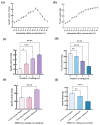The Isolation, Identification and Immobilization Method of Three Novel Enzymes with Diosgenin-Producing Activity Derived from an Aspergillus flavus
- PMID: 38139441
- PMCID: PMC10743735
- DOI: 10.3390/ijms242417611
The Isolation, Identification and Immobilization Method of Three Novel Enzymes with Diosgenin-Producing Activity Derived from an Aspergillus flavus
Abstract
Diosgenin is an important raw material used in the synthesis of steroid drugs, and it is widely used in the pharmaceutical industry. The traditional method of producing diosgenin is through using raw materials provided via the plant Dioscorea zingiberensis C. H. Wright (DZW), which is subsequently industrially hydrolyzed using a high quantity of hydrochloric and sulfuric acids at temperatures ranging from 70 °C to 175 °C. This process results in a significant amount of unmanageable wastewater, creates issues of severe environmental pollution and consumes high quantities of energy. As an alternative, the enzymolysis of DZW to produce diosgenin is an environmentally and friendly method with wide-ranging prospects for its application. However, there are still only a few enzymes that are suitable for production on an industrial scale. In this study, three new key enzymes, E1, E2, and E3, with a high conversion stability of diosgenin, were isolated and identified using an enzyme-linked-substrate autography strategy. HPLC-MS/MS identification showed that E1, a 134.45 kDa protein with 1019 amino acids (AAs), is a zinc-dependent protein similar to the M16 family. E2, a 97.89 kDa protein with 910 AAs, is a type of endo-β-1,3-glucanase. E3, a 51.6 kDa protein with 476 AAs, is a type of Xaa-Pro aminopeptidase. In addition, the method to immobilize these proteins was optimized, and stability was achieved. The results show that the optimal immobilization parameters are 3.5% sodium alginate, 3.45% calcium chloride concentration, 1.4 h fixed time, and pH 8.8; and the recovery rate of enzyme activity can reach 43.98%. A level of 70.3% relative enzyme activity can be obtained after employing six cycles of the optimized technology. Compared with free enzymes, immobilized enzymes have improved stability, acid and alkaline resistance and reusability, which are conducive to large-scale industrial production.
Keywords: dioscin-glycosidase; enzyme immobilization technology; identification; isolation; stability.
Conflict of interest statement
The authors declare no conflict of interest.
Figures







References
-
- Zhang X., Jin M., Tadesse N., Dang J., Zhou T., Zhang H., Wang S., Guo Z., Ito Y. Dioscorea zingiberensis C. H. Wright: An overview on its traditional use, phytochemistry, pharmacology, clinical applications, quality control, and toxicity. J. Ethnopharmacol. 2018;220:283–293. doi: 10.1016/j.jep.2018.03.017. - DOI - PubMed
-
- Zhang X.X., Ito Y., Liang J.R., Liu J.L., He J., Sun W.J. Therapeutic effects of total steroid saponin extracts from the rhizome of Dioscorea zingiberensis C.H.Wright in Freund’s complete adjuvant induced arthritis in rats. Int. Immunopharmacol. 2014;23:407–416. doi: 10.1016/j.intimp.2014.07.018. - DOI - PMC - PubMed
-
- Pang X., Huang H.Z., Zhao Y., Xiong C.-Q., Yu L.Y., Ma B.-P. Conversion of furostanol saponins into spirostanol saponins improves the yield of diosgenin from Dioscorea zingiberensis by acid hydrolysis. RSC Adv. 2015;5:4831–4837. doi: 10.1039/C4RA12709A. - DOI
MeSH terms
Substances
Grants and funding
LinkOut - more resources
Full Text Sources
Research Materials

